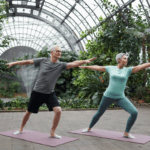Coming Soon: E-book about Kundalini Yoga - Sign up here to be among the first to get it!
As we age, maintaining physical health and mental well-being becomes increasingly crucial. Yoga, with its holistic approach, offers an ideal form of exercise for seniors, blending physical activity with mental relaxation. This article introduces a yoga practice specifically designed for older adults. This yoga practice focuses on improving flexibility, enhancing balance, and strengthening muscles, all of which are key for mobility and injury prevention in later years. Additionally, the meditative aspects of yoga contribute to stress reduction and mental clarity. In the article, we will present the basic poses and variations specifically thought for elderly students. These poses are adaptable to varying fitness levels and physical limitations, this sequence is accessible and beneficial for seniors looking to enrich their quality of life through gentle yet effective exercise. You can check out these articles Gentle Yoga for Seniors, A Gentle Chair Yoga Practice for Beginners and Seniors. If you are a practitioner, our advice is to find a yoga instructor who can help you and guide you through your yoga routine, providing you with the proper adaptations to suit your body. If you are a yoga teacher, whether you specialize or not on senior yoga or chair yoga, you can check this article Boosting Wellness: An Essential Guide to Yoga for Seniors, and make sure you check out these yoga stretches below!
Join us in exploring how yoga can be a rewarding addition to your daily routine, fostering both physical and mental resilience.
Beginner Yoga for Senior
As we journey through life, our bodies and minds naturally evolve, experiencing unique physical and mental states at each stage. The process of aging affects individuals in diverse ways. Two people of the same age might display distinct signs of aging, both physically and mentally.
With advancing years, many individuals face physical transformations that can turn routine tasks into challenges. This might include a decrease in confidence, a reduction in bone and joint size, diminished flexibility, and a lessened sense of balance. Some might encounter health issues like digestive problems, reduced lung efficiency leading to lower oxygen levels, and heart function irregularities. These physical struggles often contribute to inadequate sleep, mild depression, mood fluctuations, and an overall decline in well-being.
Yoga offers a valuable tool to enhance life quality for those over 60. The following yoga sequence incorporates gentle stretches and poses, specifically designed to support spine movement. This approach not only aids in building a stronger digestive system but also increases lung capacity through the practice of pranayama. Considering the median age of 70 and the average fitness levels of your students, this sequence is an excellent resource for yoga teachers. It’s crafted to be adaptable, allowing you to tailor it to each student’s unique physical needs, ensuring an effective and nurturing yoga experience.
The Transformative Benefits of Yoga for Seniors
Embracing Yoga in the Golden Years: Benefits
As we enter our senior years, embracing practices that nurture both our bodies and minds becomes increasingly important. Yoga, an ancient practice with timeless relevance, offers a myriad of benefits tailored to the needs and challenges of older adults.
1. Enhanced Flexibility and Mobility
- A Gentle Approach to Movement: Yoga poses, known as asanas, are designed to increase flexibility gradually. This is crucial for seniors, as flexibility tends to decrease with age, impacting mobility and the ability to perform daily activities.
- Reducing Stiffness and Pain: Regular yoga practice can alleviate stiffness and joint pain, common issues in older age, making everyday movements smoother and less painful.
2. Improved Balance and Stability
- Preventing Falls: Balance-enhancing yoga poses help seniors maintain stability, which is vital in reducing the risk of falls, a common concern for the elderly.
- Mind-Body Connection: Yoga fosters a deeper awareness of the body, improving proprioception – the sense of how our bodies are positioned in space.
3. Strengthening Muscles
- Building Strength Gently: Yoga helps in strengthening muscles, which is essential for maintaining independence in senior years. The practice focuses on using body weight to build strength in a safe, low-impact way.
4. Boosting Mental Health and Cognitive Function
- Stress Relief and Mental Clarity: The meditative aspect of yoga, combined with deep breathing techniques, reduces stress and anxiety, promoting mental clarity and a sense of peace.
- Enhancing Cognitive Abilities: Regular yoga practice has been linked to improved concentration, memory, and cognitive functioning.
5. Improved Respiratory Efficiency
- Breathing Techniques: Pranayama, or yogic breathing exercises, improve lung capacity and respiratory efficiency, which is particularly beneficial for seniors.
6. Promoting Digestive Health
- Stimulating Digestion: Certain yoga poses can stimulate the digestive system, aiding in more efficient digestion and alleviating common gastrointestinal issues.
7. Community and Social Connection
- A Sense of Community: Joining a yoga class, whether it might be restorative yoga or chair yoga, provides an opportunity for social interaction, fostering a sense of community and reducing feelings of loneliness or isolation.
8. Holistic Well-being
- Overall Health and Wellness: Yoga encourages a holistic approach to health, addressing physical, mental, and emotional well-being, crucial for a fulfilling senior life.
Yoga is more than just a physical practice; it’s a journey towards holistic health, offering seniors a path to a more balanced, healthy, and joyful life. Whether it’s through improved physical strength, mental clarity, or emotional resilience, yoga helps you experience a more vibrant and fulfilling life experience.
15 Beginner Yoga Poses for Seniors
In the world of yoga, there’s a belief that the flexibility of your spine reflects your true age. This flexibility isn’t just a physical attribute; it’s deeply connected to the very essence of life – breathing. Our spine is supported by muscles engaged in breathing, making each breath a testament to vitality. Breathing, in its fullest and deepest form, fills not only our lungs but our lives with joy, life, and sparkle. It keeps us upright, energized, and open to life’s flow.
At the same time, improper breathing can have the opposite effect. Shallow breaths lead to a hunched posture, a physical manifestation of closing ourselves off from the world. This posture is not just a bodily response but is connected to our emotional state. Research has highlighted a direct correlation between posture and emotions, showing how our physical stance can mirror, and even influence, our feelings.
To learn more about this fascinating connection, you’ll find more insights in the following sections. In the meantime, let’s explore these 10 beginner yoga poses for seniors. Each pose comes with suggested variations to accommodate different levels of flexibility and comfort.
Remember, whether you’re a yoga practitioner yourself or a yoga instructor, it’s crucial to listen to the body’s signals. Respect these cues and make the necessary adjustments to ensure a safe, enjoyable, and beneficial yoga experience.
Mountain Pose Variation Feet Hip Wide (Tadasana Variation Feet Hip Wide)
Instructions: Stand with feet hip-width apart. Ground your feet firmly, distributing your weight evenly. Engage your thigh muscles gently, draw your tailbone down, and lift your chest. Relax your shoulders and let your arms hang naturally with palms facing forward.
Variation for Seniors: Use a wall for support if balance is a concern. Keep a chair nearby for stability.
Benefits: Improves posture, strengthens thighs, knees, and ankles, and reduces flat feet.
Standing Deltoids Stretch (Tadasana Deltoids Stretch)
Instructions: Stand in Mountain Pose. Extend your right arm across your body. Use your left hand to gently press the right arm closer, stretching the deltoid muscle.
Variation for Seniors: Perform this stretch seated if standing is uncomfortable.
Benefits: Stretches shoulder muscles, and releases tension in the neck and shoulders.
Standing Shoulder Rolls
Instructions: Stand or sit upright. Roll your shoulders slowly up, back, and down in a circular motion.
Variation for Seniors: Perform seated with back support if needed.
Benefits: Relieves stiffness in the shoulders and neck, and improves posture.
Neck Rotation And Massage
Instructions: Sit or stand comfortably. Slowly rotate your head from side to side, then gently tilt it forward and backward.
Variation for Seniors: Limit the range of motion if there is any discomfort.
Benefits: Increases neck mobility, and reduces tension in neck muscles.
Standing Side Bend Pose Variation (Eka Hasta Parsva Bhanga Variation)
Instructions: Stand with feet together. Raise one arm overhead and lean to the opposite side, keeping your other arm down.
Variation for Seniors: Keep a chair nearby for balance, and reduce the bending range.
Benefits: Stretches the sides of the body, improves breathing, and enhances posture.
Standing Side Stretch Pose (Katichakrasana)
Instructions: Stand with feet hip-width apart. Extend your arms forward at shoulder level, then twist your upper body to one side, keeping your hips facing forward.
Variation for Seniors: Perform the twist with hands on the waist or a chair for support.
Benefits: Enhances spinal flexibility, tones abdominal muscles, and improves digestion.
Mountain Pose Twist Arms Shoulder Level (Tadasana Twist Arms Shoulder Level)
Instructions: Stand in Mountain Pose. Extend your arms at shoulder level and twist your torso to one side, then the other, keeping your hips steady.
Variation for Seniors: Use a chair for balance, and limit the twist range as needed.
Benefits: Increases spinal mobility, strengthens abdominal muscles, improves posture.
Standing Pelvic Circles
Instructions: Stand with feet hip-width apart, hands on hips. Move your pelvis in a circular motion.
Variation for Seniors: Perform near support or seated on a chair.
Benefits: Loosens the lower back and hip joints, and improves pelvic mobility.
Intense Leg Stretch Pose Variation Blocks (Prasarita Padottanasana Variation Blocks)
Instructions: Stand with feet wide apart, hinge at hips to fold forward, hands-on yoga blocks for support.
Variation for Seniors: Keep the spine elongated, bend knees slightly, and use higher blocks.
Benefits: Stretches the back of the legs, strengthens the spine, calms the mind.
Seated Torso Circles (Kundalini Circles)
Instructions: Sit on a chair, feet flat on the ground. Place hands on knees. Gently circle your torso in a clockwise direction, then counter-clockwise.
Variation for Seniors: Reduce the range of motion, and perform more slowly.
Benefits: Increases lower back and abdominal flexibility, and stimulates digestive organs.
Wind Release Pose (Pawanmuktasana)
Instructions: Lie on your back. Gently bring your knees to your chest, holding them with your hands. Rock slightly if comfortable.
Variation for Seniors: Place a pillow under your head for support. If holding both knees is difficult, try one leg at a time.
Benefits: Aids in digestion, relieves gas and bloating, and eases lower back tension.
Supine Spinal Twist Pose II (Supta Matsyendrasana II)
Instructions: Lie on your back, arms out to the sides. Bring one knee to the chest, then gently twist it across your body, turning your head in the opposite direction.
Variation for Seniors: Place a cushion under the knee or between the knees for support. Limit the range of the twist as needed.
Benefits: Promotes spinal flexibility, stimulates digestion, and relieves stress.
Fish Pose Bolster (Matsyasana Bolster)
Instructions: Sit with a bolster behind you. Lie back slowly, so the bolster supports your spine and head. Extend your legs and relax your arms.
Variation for Seniors: Use additional pillows for extra support, especially under the head and knees.
Benefits: Opens the chest and shoulders, improves respiratory function, and reduces stress.
Seated Cat Cow Pose (Upavistha Bitilasana Marjaryasana)
Instructions: Sit on a chair with your feet flat on the ground. For the cow pose, arch your back, and look up, expanding the chest. For the cat pose, round your spine, dropping your head forward.
Variation for Seniors: Perform the movements gently, focusing on the upper back rather than the lumbar region.
Benefits: Increases spine flexibility, relieves tension in the back and neck, and enhances posture.
Meditation
Instructions: Sit comfortably, either on a chair or on the floor with a cushion. Close your eyes, relax your body, and focus on your breath.
Variation for Seniors: If sitting for long periods is uncomfortable, try lying down or using props for support.
Benefits: Reduces stress and anxiety, enhances mental clarity, promotes emotional well-being.
This mini yoga sequence for beginners is specifically designed with seniors in mind, prioritizing safety, ease, and maximum benefit. It is important to remember that the key to practicing yoga, especially for seniors, is to listen to your body and stay within your comfortable limits. .
Conclusion
As we wrap up our exploration of beginner yoga for seniors, it’s clear that this ancient practice offers a wealth of benefits uniquely suited to the golden years of life. Yoga is not just about maintaining physical flexibility; it’s a holistic journey that nurtures the mind, body, and spirit, fostering a sense of harmony and well-being.
For seniors embarking on this yoga journey, the key is to approach each pose with patience and self-compassion. Remember, yoga is not a competition; it’s a personal practice where gradual progress and consistency are more valuable than perfection. The gentle stretches, mindful breathing, and meditative focus of yoga can lead to remarkable improvements in overall health, mobility, and mental clarity.
Through the yoga poses we’ve explored, seniors can find a renewed sense of balance, strength, and vitality. These benefits extend beyond the yoga mat, enhancing daily life activities and offering tools to manage stress and cultivate inner peace.
Yoga also opens the door to a supportive community, where connections are formed and experiences are shared. This social aspect is invaluable, contributing to emotional health and a sense of belonging.
As we conclude, let’s remember that yoga is a journey of continuous discovery. Whether you are a senior beginning this practice, or a teacher guiding others, each session is an opportunity to explore and celebrate the capabilities and potential of the senior body and mind. In embracing yoga, seniors can truly experience the grace and joy of aging with vitality and serenity.
May this journey bring you health, happiness, and an ever-deepening appreciation for the wonders of life at any age. Namaste.



